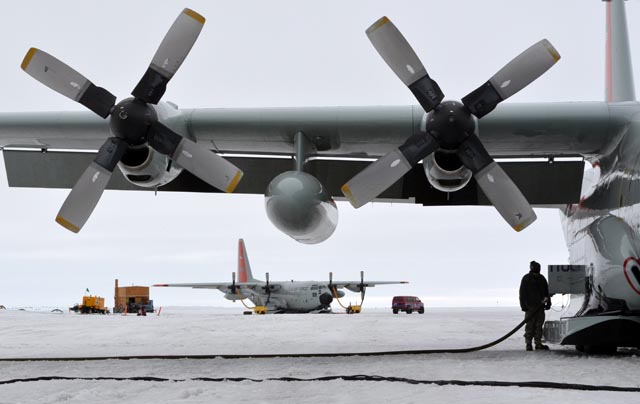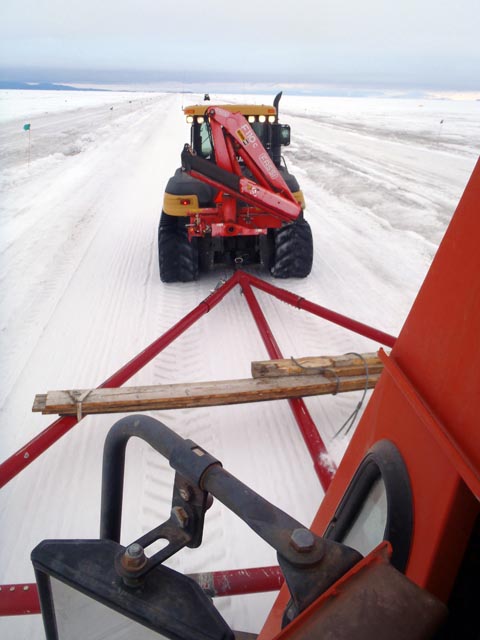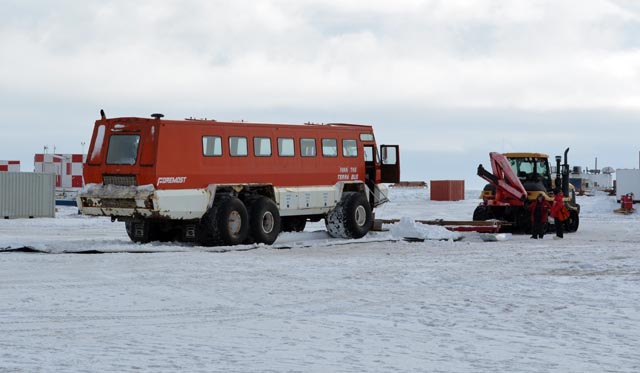|
Bumpy rideMelt issues at airfield, snow roads disrupt transportation at McMurdoPosted February 22, 2013
A “perfect storm” of warm temperatures and a big blow of dust caused disruptions at McMurdo Station’s It started with a vigorous wind storm on Dec. 7 from the south-southwest that scoured sand from Black Island, a relatively snow-free island across McMurdo Sound. These winds transported and deposited a layer of dark mineral dust from Black Island across a long, narrow stretch of the ice shelf, including Pegasus Airfield Such storms in that region are not uncommon, according to George Blaisdell, operations manager for the U.S. Antarctic Program (USAP) “It was a bit more widespread; it covered a larger area. It appears to have had a larger volume than usual,” Blaisdell explained. The dark particles on the snow surface more readily absorb solar radiation. There was plenty of sun and heat, with average temperatures about 2 degrees Celsius above average during the height of the austral summer in December and January, according to Blaisdell. Several days the mercury ventured around 40 degrees Fahrenheit. “The volume, aerial extent and the timing [of the dust storm], together with the air temperature, was sort of the perfect storm for a problem out there,” Blaisdell said. Pegasus Airfield is located about 14 miles away from Ross Island, where McMurdo Station and New Zealand’s Scott Base Large wheeled aircraft like the U.S. Air Force’s C-17 Globemaster III Both runways were affected by the dust and warm temperatures, particularly the compacted pavement of the ice runway. The last three miles or so of the snow road also suffered damage, turning sections into a slushy swamp that made the 45-minute trip to the airfield into a two-hour slog. Some vehicles had to be towed by tractors aboard a sled for the last few miles. The ice runway for wheeled aircraft had been closed since late December, forcing several mid-season flights by Australia’s Airbus A-319 to be canceled. The problem became more acute as the 2012-13 summer season begins to wind down because the C-17 was scheduled to begin flying again on Jan. 21. The ice runway didn’t reopen to wheeled aircraft until Feb. 11. The LC-130s had been carrying the passenger loads between Christchurch, New Zealand (the gateway city for the USAP), and McMurdo Station. The problem was that the National Guard planes can only carry about 30 to 40 passengers, depending on weight, versus about 120 people on the C-17. The flights are also longer aboard the smaller planes — eight hours versus five aboard the bigger, more powerful jets. In addition, the unexpected need to use the LC-130 aircraft for intercontinental passenger services meant fewer flights were available for supporting fuel and cargo operations at the South Pole Station “It’s really starting to have an impact,” said Al Martin, McMurdo area manager for the USAP, at the end of January. Pegasus is one of three airfields near McMurdo Station. The so-called Annual Sea Ice Runway is a temporary airstrip built each year on the sea ice in close proximity to McMurdo. It’s generally in operation for the months of October and November before the sea ice begins to thin and deteriorate. Williams Field, about seven miles away from McMurdo on the snow road, has been inactive for the past four seasons, except as a backup to Pegasus for ski-quipped aircraft. It used to be the primary airfield during the middle of the summer when only ski-equipped planes flew at that time. Now the site is primarily used by NASA Pegasus Airfield was established more than 20 years ago, during the 1990-91 field season, after a 1988 proposal to build a new airfield at the site of a former backup airfield known as Outer Williams Field. The airfield was originally built as a blue-ice runway, an area where there is little snow accumulation and the ice ablates. Accumulation starts to build moving northeast toward Williams Field, which can accumulate as much as three feet of snow per year. Pegasus was named after a C-121 Lockheed Constellation that made a hard landing at the sea ice runway site on Oct. 8, 1970. No one was injured, but the plane was seriously damaged. After stripping useful parts, the aircraft was towed to Outer Williams Field to provide an emergency shelter; the plane is still visible at the surface. In 2002, the USAP turned the glacial ice into a white-ice runway capable of supporting wheeled aircraft throughout the year — even during the height of the summer. The ice “pavement” is a thin, highly compacted snow cover capable of supporting the high contact pressure of the C-17 and other large wheeled aircraft. The compaction process normally protects the runway from sun damage. Blaisdell said he believes the dust storm was a major part of the problem in the melting of the ice runway, because the snow road closer to town remained in good shape throughout the above-average summertime temperatures. “My feeling is that we know enough now that we can sustain good quality roads through a warmer-than-average summer, but if you kick a bunch of dirt at us, that’s what tips us over,” he said. However, Blaisdell also said that there were maintenance problems associated with the dust that caused the ice to develop a sheen, which allowed solar radiation to penetrate the ice surface and create melt pools. He had hoped the C-17s would have been flying before Feb. 1. It took another 10 days before the first flight could be cleared for landing at Pegasus. The NSF sought and obtained a waiver from the U.S. Air Force to allow the aircraft to land on a reduced runway of 90 by 9,000 feet. Efforts are under way to recover and re-certify all of the runway, so that it will be ready to support full air operations in August. The United States isn’t the only nation that had trouble with melt issues at its ice-based runway in Antarctica. The Australian Antarctic Division’s Blaisdell said he believes that Pegasus Airfield as a single, year-round airport for McMurdo Station is still viable, despite the challenges this season. “It makes good sense on paper. In practice, it has worked,” he said. |



For USAP Participants |
For The Public |
For Researchers and EducatorsContact UsU.S. National Science FoundationOffice of Polar Programs Geosciences Directorate 2415 Eisenhower Avenue, Suite W7100 Alexandria, VA 22314 Sign up for the NSF Office of Polar Programs newsletter and events. Feedback Form |






